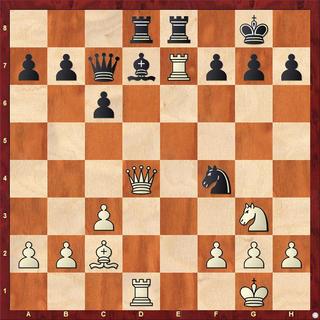White to Play
Published in Chess Puzzles

Enter New GameFrom Janowski-Burn, Ostend, 1907. The Four Knights has a dull and drawish reputation today, but back in the day it could explode suddenly as this game attests. 1.e4 e5 2.Nf3 Nc6 3.Nc3 Nf6 4.Bb5 Bb4 5.0–0 0–0 6.d3 d6 [Yawn, huh?]7.Ne2 Ne7 8.Ng3 c6 9.Ba4 Ng6 10.d4 exd4 11.Nxd4 d5 12.exd5 Nxd5 13.c3 Bc5 14.Bc2 Bxd4 [Up to now it was completely equal, but Black now makes a minor error. No need to trade a bishop for a knight on an open board. 14...Re8; 14...Qc7]15.Qxd4 Ndf4 16.Rd1 Qc7 [White gets the initiative after 16...Qxd4 17.Rxd4! Nd5 18.Bg5 Re8 19.c4]17.Re1 Bd7?? [Necessary was 17...Rd8]18.Bxf4 Nxf4 19.Re7 Rad8 20.Rd1 [Piling on the pinned bishop.] 20...Rfe8 and now White played… SEE DIAGRAM
The axe falls with 21.Qxd7!! and Black Resigned. [It would be very embarrassing for White to play 21.Rxd7 Rxd7 22.Qxd7 Qxd7 23.Rxd7 Re1+ 24.Nf1 Ne2+ 25.Kh1 Rxf1#; 21.Rxe8+ only wins a pawn.] Because 21...Qxd7 22.Rdxd7 puts Black in the unenviable position of not being able to take either rook because of mate to come, and if Black doesn't take, White's doubled rooks on the 7th are deadly and will vacuum up a good deal of material.
Send questions and comments to PTamburro@aol.com.






